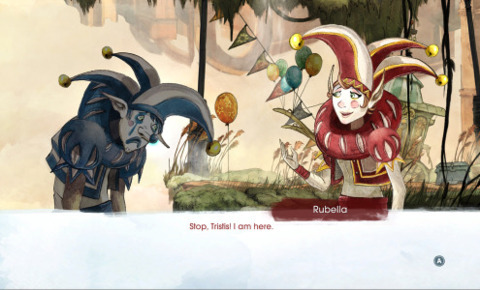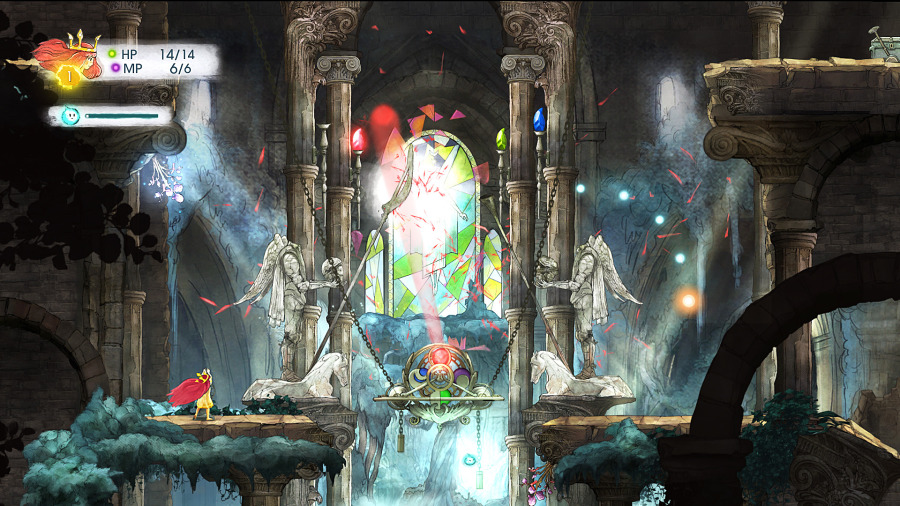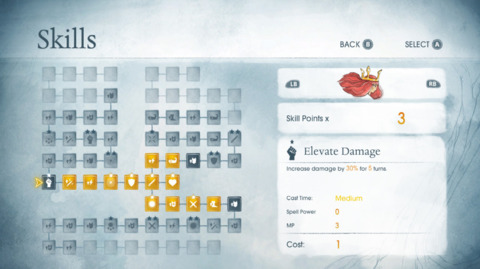Child of Light is at once a thing of beauty and a minor tragedy. Here is a game that seeks to evoke the kind of wondrous storytelling you'd find in any childhood storybook. This is a playable fairy tale, replete with all the magical kingdoms, evil stepmothers, quirky adventurers, rhyming dialogue, and hand-drawn artwork that such a description would typically come along with. Yet despite having all the pieces seemingly in place, something about Child of Light remains pervasively off. For all its allusions of wonder and childlike fantasy, its story rarely finds way to inspire any such feelings. Quirky characters continuously pop up, the plot twists and turns as any good fairy tale should, and all throughout, Child of Light delivers visual splendor after visual splendor. Yet, little of it sticks. Even now, mere hours after finishing the game, I'm finding myself oddly struggling to come up with one memorable detail about my time in Child of Light's world beyond its mere aesthetic pleasures.

Maybe "mere" is the wrong word, given how tremendously good Child of Light looks. Using Ubisoft's trademark UbiArt engine (which has most recently been used to bring Rayman Origins and Rayman Legends to life), Child of Light paints its magical world with tremendous care. Every character looks like it could have come from an old hand-painted book, every environment is full of amazing detail, and it all animates with a fluidity that makes every on-screen action--up to a point--enrapturing. Those visuals are complimented by a terrific soundtrack by Cœur de Pirate, one that's as good at emphasizing the (supposed) intensity of the game's battles as it is underscoring the tranquil beauty of the game's many low-key moments.
It's a shame, then, that Child of Light's best qualities are only skin-deep. As a fairy tale, it's fairly bland. You play as Aurora, a princess from the magical fantasy kingdom of...Austria. No, this isn't a game about a girl trekking up the Grossglockner Alpine Road. Early on, Aurora finds herself transported against her will to the land of Lemuria, a place where wizard gnomes, depressed circus performers, mercantile mice, and a variety of other people find themselves oppressed by a dark queen of...darkness? Evil? I don't know, to be perfectly frank. I read every line of dialogue in Child of Light, and I still found myself frequently wondering just what the heck was going on. Some of the details of the world and its various issues are filled in by collectible "confessions," which you'll find floating around, but that's hardly an ideal way to keep a player fixated on a story. The key thing to understand is that Aurora desperately wants to go home to her father, who has become gravely ill in her absence. Everything else around that core plot detail isn't particularly necessary.
This means that it's okay if you find yourself itching to skip through the game's aggressively twee dialogue. Everything in Child of Light rhymes. Everything. Nobody can say anything to anyone without a cutesy rhyme coming somewhere near the end of it. I understand why this is the case. Fairy tales are often told in rhyme, and that's what Child of Light is trying to be. Unfortunately, those rhymes are often more confusing than clever. Dialogue that should just be explaining what's happening often feels needlessly convoluted. When the game starts making jokes about characters that can't make rhymes, it proceeds to run those jokes into the ground almost immediately. There are at least a few instances where it tries to rhyme words that absolutely do not. It's a messy script made worse by the distinct lack of voice work. I don't mind reading in-game dialogue, but with a script so clearly meant to be lyrical in its delivery, at a certain point the words all just started to blend together in a bunch of sing-songy nonsense in my head.
So the story may be a wash, but there is still the whole game portion of the equation to consider. In this regard, Child of Light fares better, but still finds itself stumbling over its own aspirations.

Child of Light is a turn-based role-playing game. You navigate Aurora through the world of Lemuria either by running or by flying (an ability she gains soon after arriving). Every time you encounter an enemy on screen, you have two options. You can try to avoid the fight by zooming right past, or you can try to take them head-on. Assuming you do find yourself in battle, two characters from your party will appear on the battle screen alongside up to three enemies. The flow of battle is dictated entirely by a bar that sits at the bottom of the screen. On it, icons depicting each character will race toward a section of the bar that allows you to perform an action. This can be an attack, assuming a defensive position, using a potion, or any number of other things. The key is timing your actions against those of your enemies. Everything you do (outside of the defensive stance, which is instant) takes time to enact. If an enemy attacks you while you're in the middle of casting a spell, it will interrupt you, thus negating the spell and sending you back to the beginning of the bar.
Initially, this system creates a thrilling little risk/reward mechanic for how you approach battles. The only real advantage you have comes in the form of a little elemental spirit, which you control with the right stick (or a second player can control with another controller). Hovering this glowing ball over a specific enemy slows their progress on the bar, while hovering it over one of your party members slowly increases their health. That spirit can't do either of those things forever, mind you. You can collect energy for it using various plants that are scattered throughout the world and in battle screens, but they're limited.
Unfortunately, that initial thrill is negated pretty quickly by Child of Light's dearth of challenge. Most battles for the first seven or so hours of the game are a breeze. It doesn't really matter which party members you use in what situation, because few enemies are strong enough to put up a hard fight. While the easy response to this might be to just skip most battles, that means you won't be leveling up your characters, which is problematic when you first start facing tougher bosses. This turns Child of Light into a bit of an unfortunate grind, where you'll find yourself in battle after battle against mostly dull-witted foes for hours on end.
At least there is some room for variance in who you choose to bring into battle. Each character has their own set of abilities. One, for instance, is a wizard whose magical attacks play into the various elemental weaknesses of your enemies. Another, a sad jester you meet early on, mostly provides healing and spell boosts to your other party members, while occasionally making use of a quick "tumble" attack that outpaces most other enemy attacks. Each character is nicely varied, and a big part of the strategy comes from figuring out which pairing of party members best suits the enemies you're presented with. The problem is, you don't really have to start developing those strategies until considerably later in the game. I don't think I even bothered to swap a party member mid-battle until over halfway through Child of Light's 12-hour story. And by that point I'd gotten so used to everyone's attack rhythms that I was still trouncing most every enemy encounter.
Part of that probably stems from the insane frequency with which your characters level up. Every character comes with an almost ludicrously lengthy skill tree, full of minor and major upgrades for every statistical category and ability. The way things are paced, you level up after every few fights, which means you're constantly going into the game menu to fiddle around with which upgrade to assign. A lot of these are pretty inconsequential, and exist mostly as a way to space out larger upgrades that come after every four or five small ones, but there are still so many of them that it feels like you're constantly staring at that skill tree, which does break up the pacing of the game a bit. Far worse and much more useless is the game's "occuli" system, which lets you combine collected gems into buffs you can assign each character. The buffs themselves aren't without value, but having to sit and combine gem after gem while trying to chase down the ideal boosts for each character is the opposite of fun. It's just tedious busywork.

The good news is that Child of Light does get better as it goes along. Once you start fighting bosses and delving into some of the game's more elaborate dungeons, the game finally starts finding ways to trip you up. And with that added challenge, fights become more strategic, more intense, and generally more fun. That fun comes only about four or so hours from the game's conclusion, but those four hours are far more enjoyable than the preceding seven or eight. It's worth noting that Child of Light only comes with two difficulty settings, and at the time of release, those were titled "normal" and "hard." Apparently those designations are going to be patched to say "casual" and "expert," which feel more accurate to what the game actually presents. I restarted the game on "hard" after finishing it on "normal," and while the difficulty increase does make enemy encounters tougher, it doesn't entirely negate the sluggish, grindy feel of the early parts of the game. You just have to work a little harder to dispatch a lot of enemies that still don't require a ton of strategy to best.
Even with all these issues, I felt like Child of Light was a game worth seeing through to the end. Up until those last few hours, I was ready to write it off entirely. It's a shame that it takes so long to find its groove, and even when it does, it's not as if the story becomes markedly better, the dialogue any less obnoxiously opaque, nor the gameplay any less rote. But in those few hours, you catch a glimpse of a stronger, more thoughtful, more engaging experience than the gorgeous, but disappointingly empty one that makes up too much of Child of Light.